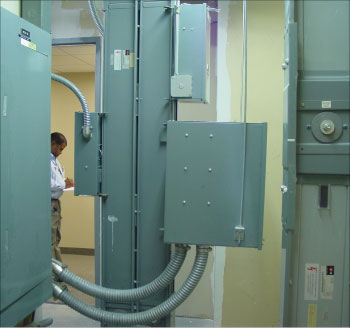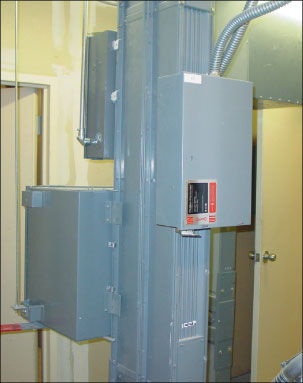 Let’s refresh a couple of well-known facts:
Let’s refresh a couple of well-known facts:
1. All electrical equipment intended to be used under provisions of the CE Code must be approved.
2. Requirements of the Canadian Electrical Code cannot create obstacles for use of any new technologies, as long as each such technology presents “approved” equipment that could be utilized forspecific applications under rules of the installation code.
Cablebus is a relevant example of such technology.
Although cablebus is not presently recognized by the rules of the CE Code (rules of its installation areacknowledged by Article 370 of the NEC), the fact is, this technology (or a product)is approved and, as such, it is allowed for use in Canada.
Based on the fact that the U.S. installation code recognizes use of cablebus, it may bring us to the conclusion that this technology is not necessarily new, and perhaps the CE Code simply did not catch up with it. This very well may be, but it is another subject, and this matter is presently being discussed by the CE Code S/C on Section 12.
Let’s take a look at this equipment and demonstrate that although the CE Code is presently silent on its installation criteria, this product could be utilized under provisions of the current CE Code requirements without any obstacles.
So, what is cablebus?
Cablebus is an assembly of insulated conductors with fittings and conductor terminations in a completely enclosed, ventilated protective metal housing. Therefore, for the purpose of the CE Code, cablebus is a complete metal cable tray system that could be installed under 12-2200– 12-2210series rules of the Code.
These Rules of the Code govern installations of cable trays.The CE Code definescable trayas “a raceway consisting of metal troughing and fittings formed and constructed so that insulated conductors and cables may be readily installed or removed after the cable tray has been completely installed, without injury either to conductors or their covering.”
This definition may appear to some as a specification for design and construction, but it is not the case. The definition simply establishes criteria for a very specific type of raceway. The CSA standard C22.2 No. 126.1”Metal Cable Tray System” sets out such design, construction, testing and marking requirements for this product. The entirecablebus assembly is custom designed and constructed to provide the electrical and mechanical requirements for installation of a non-segregated phase metal enclosed cable tray/cablebus system. This “metal cable tray/cablebus system” includes all necessary straight sections, fittings, cable support blocks, covers, splice plates, hardware, weatherproof entrance fittings, firestops, single conductor cables, compression lugs, termination kits, external supports and other accessories as required to form a complete system. Cablebus certifiedto the above referenced standard is also intended for a complete assembly at the point of installation from the components furnished and specified by the manufacturer in accordance with instructions for the specific job. This assembly is designedand constructed to support conductorswhich must be selected for the continuous load in conformance with applicable provisions of Rule 8-104 of the CE Code.

Photo 2
This assembly is also designed to carry the available fault current and to withstand the magnetic forces of such current.
A complete set of engineering drawings and installation drawingsmust be made available for each system to facilitate system design, construction and installation,to include electrical detail of the conductors together with enclosure dimensions and to specify maximum allowable loading at each point of support.The installation drawingsmust indicate the load required to be supported at each individual indoor and outdoor support. Each straight section and fittingmust be individually identified with an affixed label to correspond to an itemized list as shown on the installation drawing.
Cable support blocksof such cable tray/cablebus system must be designed and constructed to accommodateconductors approvedfor a permanentinstallation in a cable tray in accordance withapplicable provisions of Table 19 of the CE Code.
Conductors specified in Table 19 of the CE Codemust be selected for each cable tray/cablebus system in accordance with their current-carrying ampacities under the relevant provisions of Rule 12-2210 (i.e., ratedfor installation in a free airas per Tables 1 or 3or forinstallation in raceways as per Tables 2 or 4). These ampacities may not necessarily be selected in accordance with values of Tables 1 – 4, but could be chosenin accordance with the manufacturer’s specification provided that technical datasupplied by the cable manufacturer is consistent with IEEE 835, and this data is acceptable to the AHJ. This latter provision of the CE Code is articulated in Appendix B Note on Rule 4-004(1) and (2).
So far so good, but what about bonding of cablebus?
Is a separate bonding conductor necessary? Let’s reviewapplicable requirementsof the CE Code.
Rule 12-2208 of the 2009 edition of the CECclearly states that metal supports for the metal cable tray are deemed to be sufficient bonding means.
Further, Rule 10-804(g) of the CE Codearticulates that unless specifically prohibited byRule 10-618, metal raceway is considered as adequate material for bonding conductors.
Rule 10-618(1)(a) emphasizes that a metal raceway is considered as an effective bonding means, and sets a number of restrictions wheresuch conditions do not apply. As it has been shown above, cable tray is a metal raceway by definition. Thus, allinterconnected (bolted together) metal components of a cablebus that provide a reliable electrical continuity and that form an effective equipotential planeare not required to be provided with a separate bonding conductor sized in accordance with Table 16.
Appendix B Note on Rule 10-814(1) shown on page 385of the Code clarifies the fact that the metal racewaypermitted to be used as bonding conductor is deemed to be of adequate size for the purpose of this Rule.
And finally, let’s discuss conditions of use of this product.
The CEC does not impose any specific restriction on installation of cable trays, but it clearly stipulates that conductors installed in a cable tray must have a continuous metal sheath or interlocking armour. Alternatively, the Code allows use of type TC tray cables only in areas of industrial establishments that are not accessible to the public, provided that specific conditions of Rule 12-2202(2) are met.
So, what about cablebus? Can it be used in typical institutional, commercial, office or assembly occupancies, or its application should be also limited to the industrial establishments? Hopefully, the Subcommittee for Section 12 of the CEC will be able to evaluate all relevant conditions of cablebus use.
I’m sure that the technical experts will develop a set of requirements that will not be dependent on a type of occupancy where this product could be installed, but will set out objective criteria for conditions of use based on:
(a)protection of contact with conductors by design and construction of cablebus enclosure, or
(b) the following alternative conditions for the areas of intended installation:
(i) access to cablebus only to authorized persons;
(ii) isolation of cablebus by elevation or barriers; and
(iii) where qualified electrical maintenance personnel are readily available to service the installation.
Meanwhile, one thing is clear: cablebus is approved product, and it can be installed under provisions of the Code.
And as always, authorities with jurisdictional power for acceptanceof such installations must be consulted — to discuss specifics.











Find Us on Socials